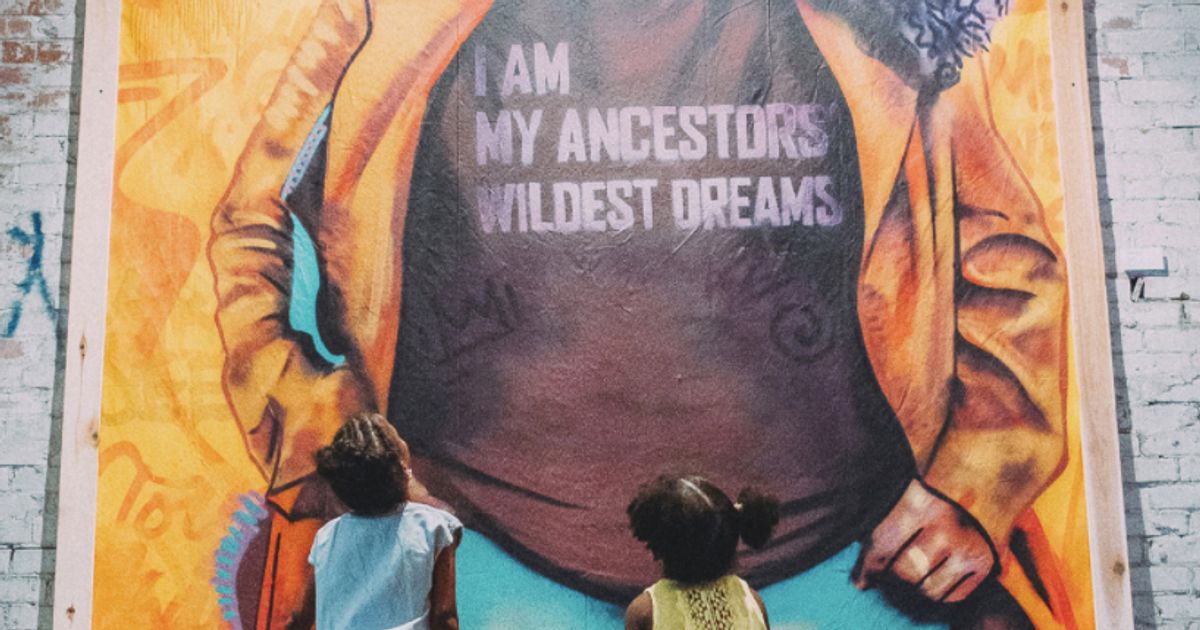Category: Painting
Artist Transforms Abandoned Buildings In New Orleans With Powerful Art
[ad_1]
For the past four years, Brandan “BMike” Odums has been transforming blighted spaces in New Orleans’ poor neighborhoods through powerful art.
Odums spray-paints larger-than-life murals of African-American icons like Malcolm X, Harriet Tubman and Martin Luther King Jr. at abandoned sites, some of which have been falling apart since Hurricane Katrina.
The New Orleans native aims to criticize how the city neglected under-resourced neighborhoods after the 2005 natural disaster ― but also wants to celebrate the residents of these mostly-black neighborhoods and the pride and beauty of their communities.
“Think about the spaces, they were in black, poor communities,” Odums told HuffPost. “[The art is] just to feel like you matter and you have value, so people can see themselves reflected in this portrait of Mohammed Ali or Maya Angelou.”
“Seeing a 12-foot painting of a person of color, it immediately asks a question of why it’s this large: It must be valuable,” he added.
“Project Be”
Odums’ “Be” art series began with “Project Be” in 2013. Odums spray-painted an abandoned housing project in the city’s lower 9th Ward, a low-income, predominantly African-American neighborhood that’s still storm-ravaged and neglected more than a decade after Hurricane Katrina.
He and other artists covered the buildings’ decaying walls with enormous murals of famed civil rights figures, from the Black Panthers to Malcolm X to Coretta Scott King.
“New Orleans is a magical city, it’s amazing ― the resilience of the people has always surfaced,” Odums said. “My goal is to speak to issues happening in the community. We have to create the change we want to see.”
But the Housing Authority of New Orleans boarded up the property after reportedly deeming it unsafe for public visitors. So Odums moved on to a vacant apartment complex in the Algiers neighborhood, which was full of blighted properties after Katrina.
“Exhibit Be”

There, Odums ran into some luck: Bill Thomason, a director at the RDLN Foundation, a small nonprofit dedicated to charitable building projects that owned the property, came across Odums’ art in the space and loved it.
Rather than kick him out, he told Odums to keep going. So in 2014, Odums brought together dozens of artists to contribute their talents and launch “Exhibit Be,” a multistory art show celebrating black history and culture with images of Harriet Tubman and quotes like “You are your ancestors’ wildest dreams.”
“The goal of that space was to be intentional about where that property stood, to reflect the reality of living in a poorly managed housing unit that ended up being an abandoned space,” Odums told HuffPost. “I wanted [people] to understand they would not have been standing on that spot without that art, they would have been too afraid of going down the street.”
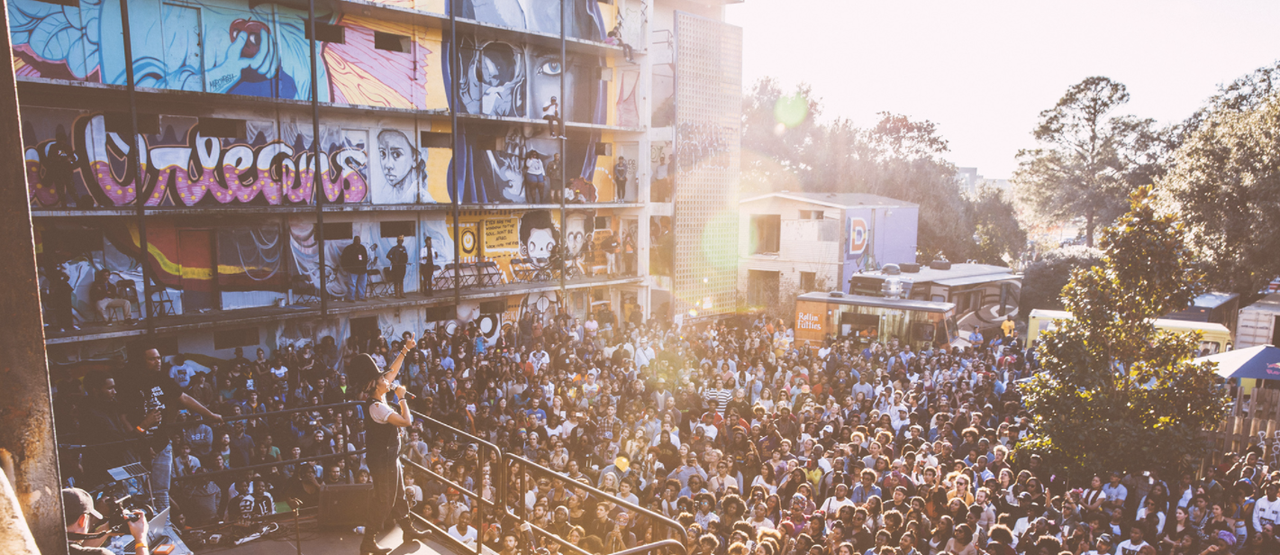
When “Exhibit Be” opened to the public in 2014, it quickly became a local success, attracting thousands of visitors, national media coverage and school trips to the space.
“It was a crazy story of how we turned lemon into lemonade,” Odums told HuffPost. “It was a space so many people avoided, and now there was a line. Erykah Badu came to the block party.”
Thomason said it was “amazing” to watch thousands of people coming to see the art.
“Especially in these times, with all this turmoil, you had people coming to visit, having conversations together ― black, white, all creeds, colors, religions ― who would just sit there, enjoying the artwork,” Thomason told HuffPost.
“Studio Be”
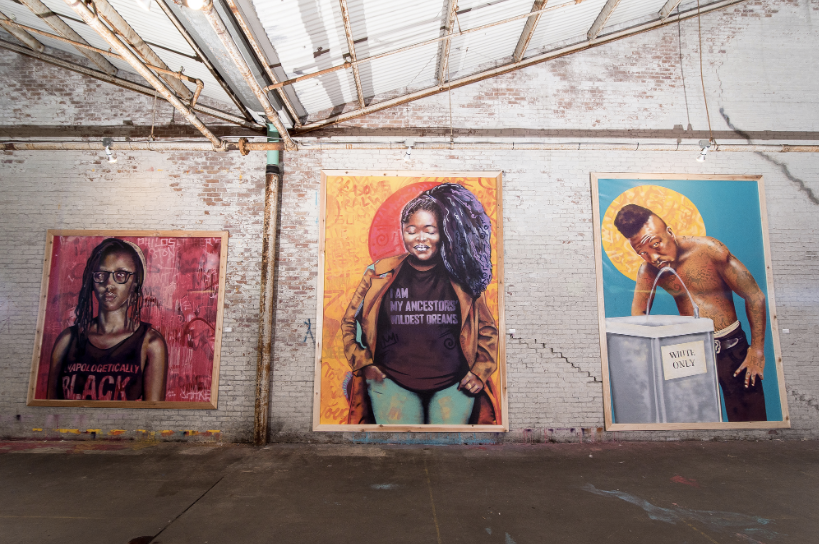
Odums’ first solo show, “Studio Be,” which kicked off in early 2016 and is currently on view in a warehouse in New Orleans’ Bywater neighborhood, is the first “Be” project to start up entirely legally.
In “Studio Be,” Odums’ large-scale murals reflect social justice issues like civil rights and police brutality. One portrait series features unarmed black men killed by police: Michael Brown, Eric Garner and Oscar Grant.
The “Studio Be” exhibit has garnered significant attention, with media coverage from high-profile anchors like Katie Couric and visits from celebrities like director Ava DuVernay, who featured the space on the OWN TV show “Queen Sugar.”
Odums says he makes a point of hosting school tours there to teach kids about lesser-known black history figures, such as Fred Hampton, a leader of the Black Panthers who was assassinated at age 21.
“It’s full circle, from starting painting in the streets without permission to coming to this space. Think about the power of art,” Odums said. “It’s about me speaking as a young black man from New Orleans, and speaking truth to that existence ― the hope, the pain, the beauty.”
Check out more of Odums’ art below and on his website.
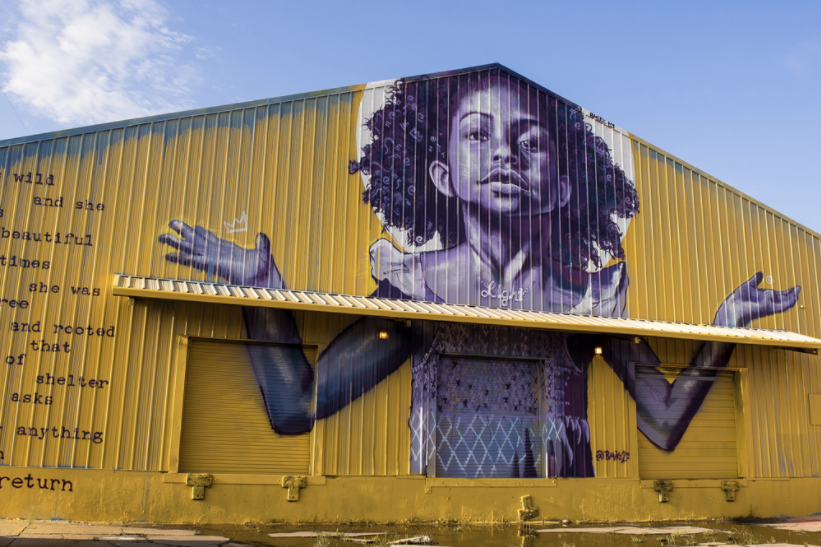
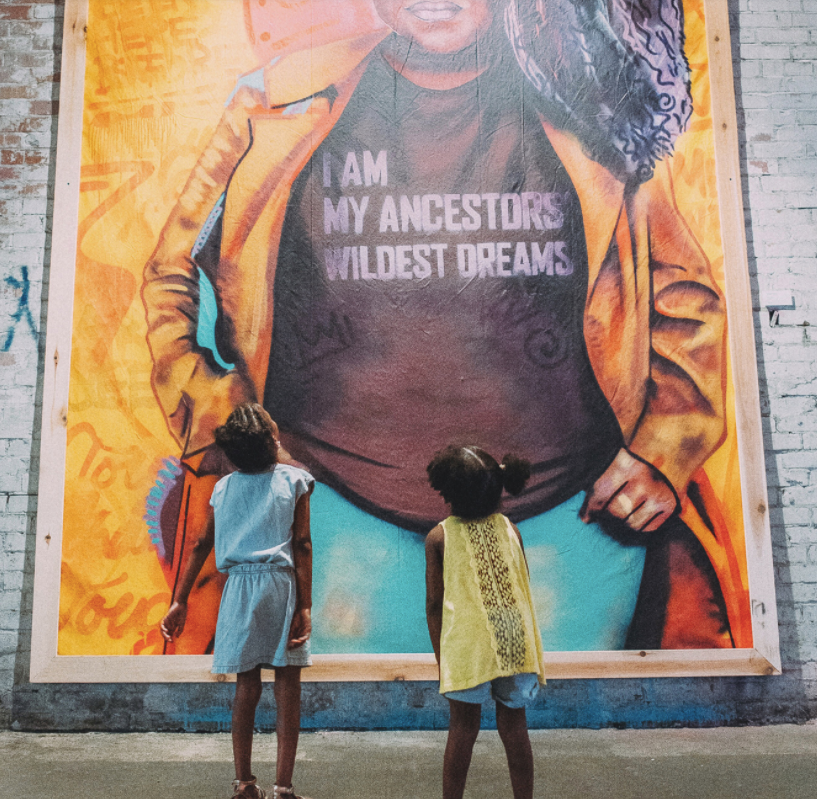
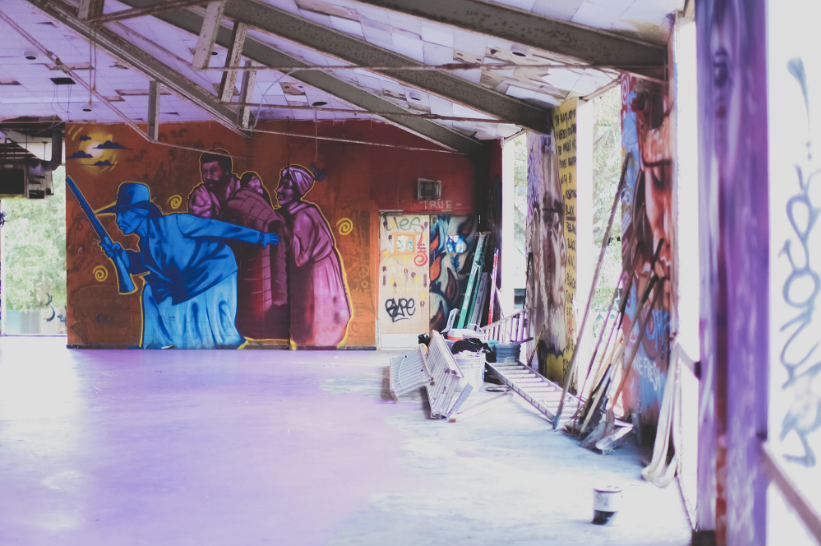
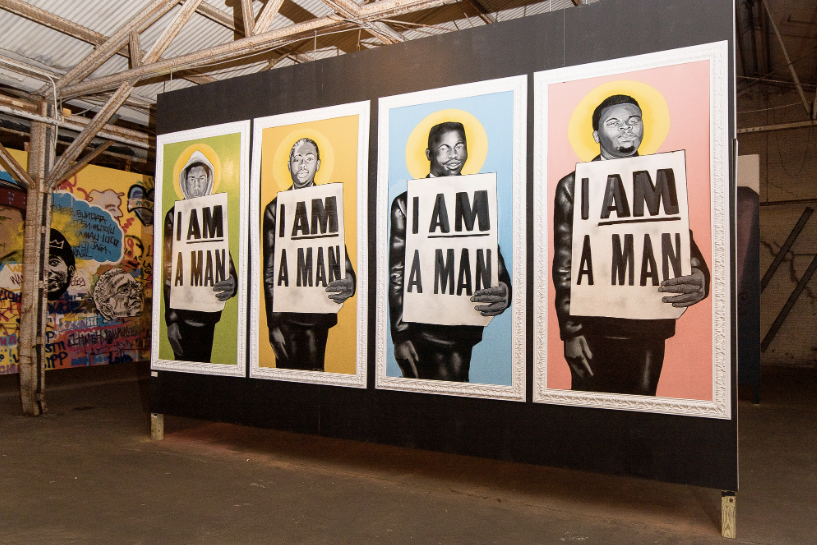
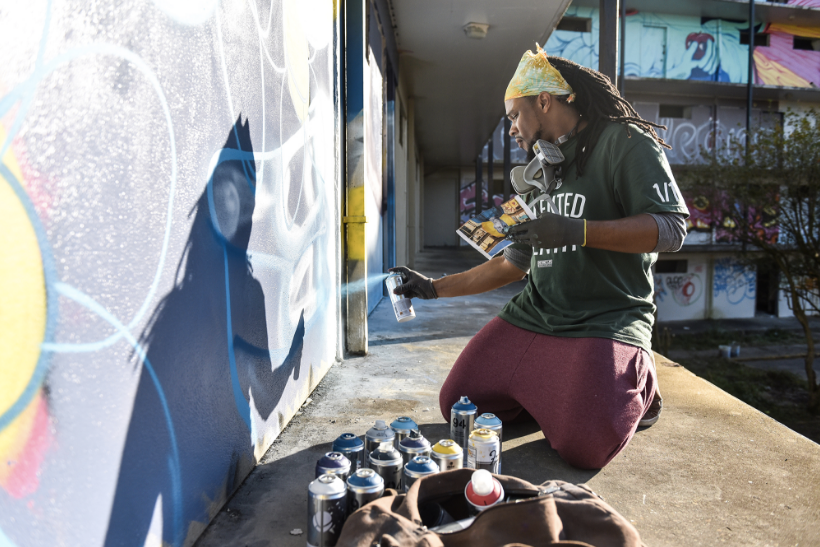
Support HuffPost
The Stakes Have Never Been Higher
[ad_2]
Source link
Kehinde Wiley Was Destined To Paint Barack Obama
[ad_1]
The presidential portraits wing of the Smithsonian National Portrait Gallery is lined with paintings of very powerful and equally pasty men. Its walls, filled with bowties, powder wigs and pursed lips, speak two well-known truths at once: Both the history of American politics and the history of Western art are blindingly white.
In 2018, however, the gallery will receive an addition unlike the rest. As was reported earlier this fall, a portrait of former President Barack Obama will join the Smithsonian ranks next year, painted by 40-year-old contemporary art star Kehinde Wiley. As a result, Obama will become the first black president featured in the gallery, and Wiley (along with Amy Sherald, commissioned to paint Michelle Obama), the first black artist to grace its halls.
The former president and first lady hand-picked the artists who will render their official portraits. And those decisions hold weight. Antwaun Sargent, a 29-year-old critic who’s covered Wiley extensively, felt personally affected by Obama’s historic choice. “I grew up in Chicago,” he told HuffPost. “I knocked on doors in the dead of winter when Obama was running for Senate. To see him choose an openly queer, black man who has devoted his career to depicting black folks, it’s really full circle for me.”
Wiley’s paintings are easy to discern. Their backgrounds typically involve a florid design quietly creeping toward the fore, its composition a melting pot of British Arts and Crafts textiles and Dutch-made African wax prints. Up front is usually a figure ― young, attractive and black ― dressed in contemporary streetwear and mimicking the stances of Old Master heroes like Napoleon Bonaparte or Charles V.
Wiley’s painted subjects are often categorized as “normal,” in that they’re not particularly rich or famous, as portrait sitters for Titian or Jacques-Louis David tended to be. Wiley scouts his subjects himself, either on the streets of New York or through open casting calls. Like many artists, Wiley has an appreciation for beauty, but he gravitates toward a lesser documented masculine allure that manifests in hip style, performative swagger, defined muscles, tattoos and radiant black skin.
“Sometimes I’d walk through the galleries just to look at the way the faces and the hands are painted, all the nuances of black,” Eugenie Tsai, the Brooklyn Museum curator who organized a 2015 exhibition of Wiley’s work, recalled.
Courtesy of the Smithsonians National Portrait Gallery Photos by Matailong Du
Once immortalized in Wiley’s massive, gold-framed canvases (they can measure as large as nine feet tall), his subjects shift from regular people to mythic giants. They ride horses like Napoleon, wield swords like Willem van Heythuysen and pose flamboyantly like Andries Stilte II, all while wearing standard blue jeans and sneakers. Wiley imbues his sitters with a gravitas and glory historically reserved for patrons, nobles and saints. His works build upon the centuries-old relationship between portraiture and power, using the canonized language of art history to exalt a new kind of subject.
“He literally is the first person I know of, throughout the history of painting, who is appropriating the entire history of art ― from cave painting on ― and bending it to his will,” Sean Kelly, founder of Sean Kelly Gallery, the gallery that represents Wiley’s work, said. “The whole history of art becomes a narrative about black presence.”
Conversations about Wiley’s work often revolve around this one specific aspect: the idea of injecting brown bodies into an all-white canon. As the artist’s straightforward and affecting statement reads: “Painting is about the world that we live in. Black men live in the world. My choice is to include them. This is my way of saying yes to us.” However, Wiley’s paintings are not simply exercises in corrective representation ― making the invisible visible. They are intended to probe the mechanics of seeing and being seen.
“Many people see my early work simply as portraits of black and brown people,” Wiley told HuffPost in May. “Really, it’s an investigation of how we see those people and how they have been perceived over time. The performance of black American identity feels very different from actually living in a black body. There’s a dissonance between inside and outside.”
Sargent described a similar dissonance between a white mainstream perception of Wiley’s subjects and his subjects’ understandings of themselves. “Kehinde saw something in these people that the larger culture didn’t see,” he said. “He believed they were heroic, that they had power. He painted people the way they imagined themselves, the way society has always ignored.”
If conventional Western portraits calcify structural power, Wiley’s are vehicles for empowerment in and of themselves. They exist in the discordant space between assumption, reality and performance, where the self is as wrapped up in artifice as authenticity. There is, therefore, a parallel between how Wiley regards his subjects and how Obama, as a young man, imagined himself.
To fête an unlikely subject is “not unlike a black man saying ‘I’m going to run for president’ when everyone is saying ‘no you can’t,’” Sargent said.
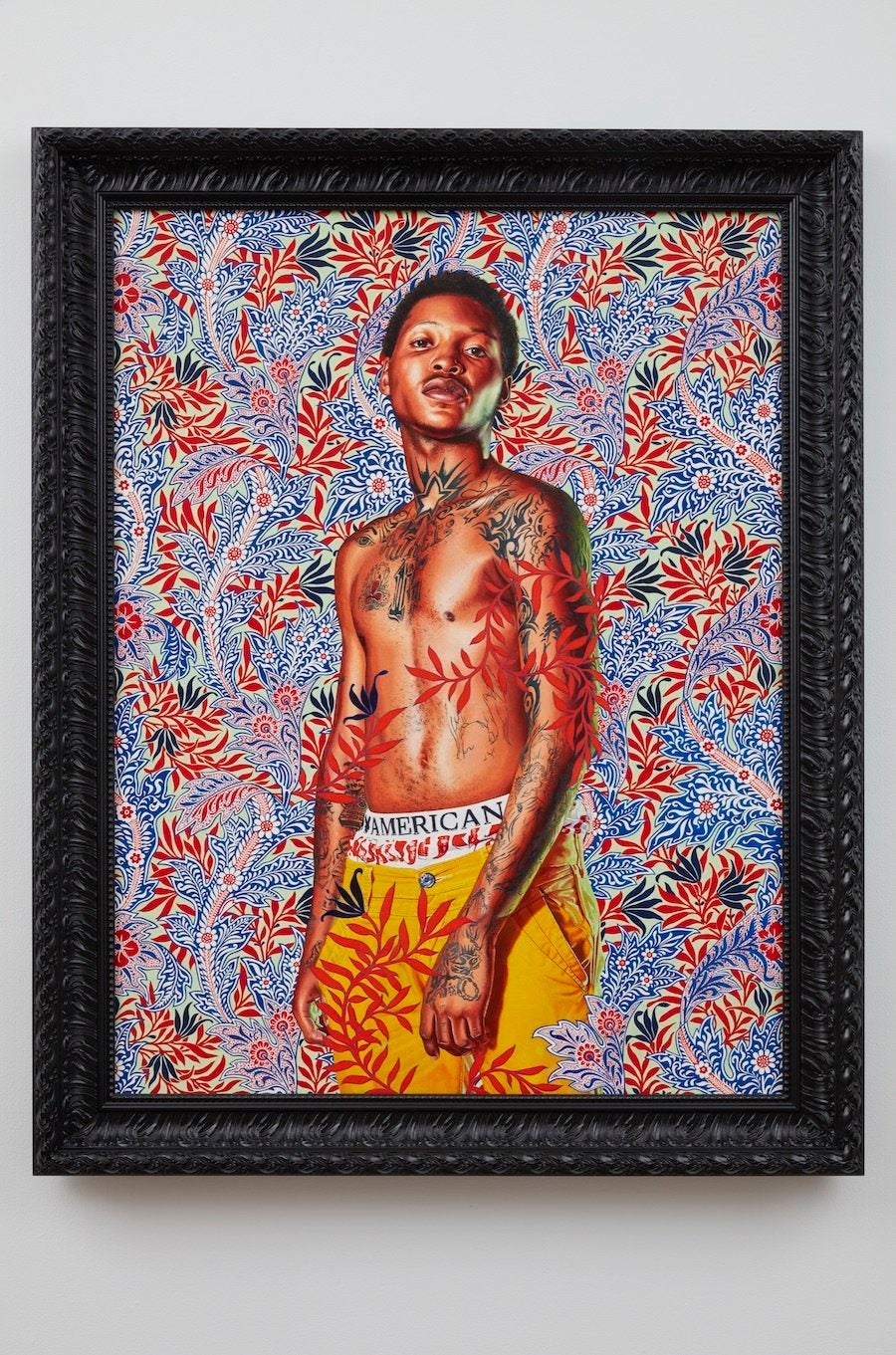
Courtesy: Sean Kelly New York
For Tsai, another overlooked element of Wiley’s work is its queerness. Female beauty has remained a near constant source of inspiration for Western artists, but appreciation of male beauty, especially black male beauty by a black male artist, can still bring a jolt to the system.
“Instead of the male gaze ― men looking at women ― you have a sense that this is a man looking at men,” she said. “It’s no secret.”
Portraying his subjects with exuberance and a hint of kitsch, Wiley embraces queerness as a lens, challenging the shallow assumptions that often beset young black men. “Wiley doesn’t only challenge the white gaze, but also the cultural gaze and the role of masculinity,” Sargent said. “It’s about black men trying to negotiate gayness in the context of mainstream gay society which has its prejudices. ’If I don’t look this way, or if I don’t act this way, am I gay? Am I black? Can you still see me?’”
There is more to Wiley’s work than the goal of diversifying subjects and artists represented in the art world. Yet that initiative ― also undertaken by artists including Kerry James Marshall, the late Barkley Hendricks, Mickalene Thomas, as well as rising artists like Jordan Casteel, Henry Taylor, Njideka Akunyili-Crosby, Toyin Ojih Odutola and many more ― has tangible effects.
The Brooklyn Museum’s 2015 mid-career survey of Wiley’s work was wildly popular, drawing around 124,000 visitors over the course of three months. More than the numbers, curator Tsai was struck by the wide range of people entering the museum’s doors: art buffs and kids walking down Eastern Parkway, hip-hop aficionados and local families.
“For me, one of the most amazing things about the exhibition was eavesdropping on the conversations going on,” Tsai said. “It made me realize that everyone should have the experience of seeing someone who looks like you hanging on the walls of a cultural institution. You think of an exhibition as the work on the walls, but the interactions between the visitors and the works of art were crucial.”
Beyond expanding the scope of museum attendees, Wiley is also helping shape the next generation of collectors. “In the short term, he’s bringing a different audience to the work,” gallerist Kelly put it. “In the long term, he’s broadening the depth of collectors for the work. Kehinde’s work is capable of touching different audiences in different ways, so the collector base is much more diverse.”
Kelly speculated that these real-world effects drive Wiley as an artist. “I think after 4,000 years of being excluded from the narrative, he wants to make sure that the next generation of kids walking into a museum don’t have to experience what he did. I think he wants everybody to feel like what they’re looking at represents them and in some way speaks to them.”
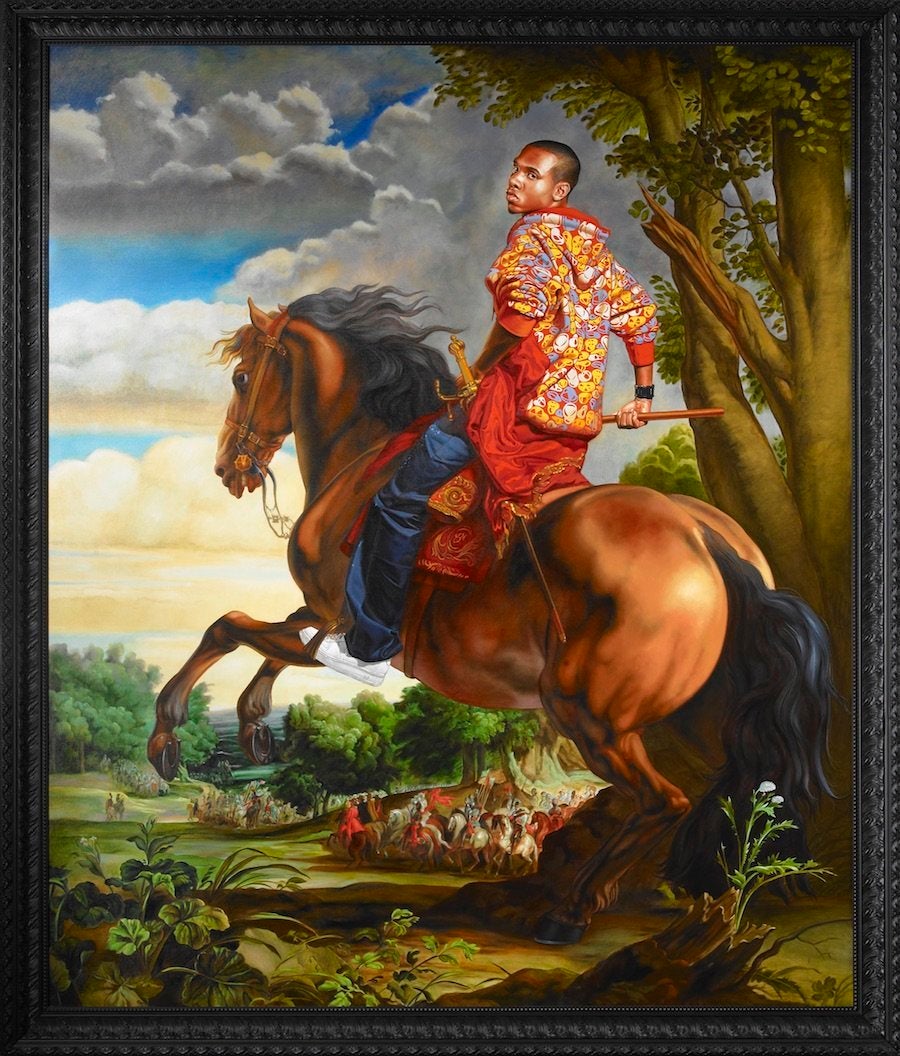
Courtesy: Sean Kelly New York
Wiley grew up in South Central, Los Angeles, with five siblings ― including a twin brother ― and his mother, who worked as a linguist before opening a junk shop in the neighborhood. Wiley was influenced by his mother’s linguistic work, which explored the friction between American Standard English and the black vernacular and code-switching black kids adopt as a method of survival.
As an adult, cast in the role of “contemporary black artist,” Wiley is cognizant of the multiple worlds he inhabits and the distinct languages each requires. “It’s about being able to play inside and outside of the race narrative at once,” the San Francisco Art Institute and Yale University School of Art alumnus said. “It’s difficult to get right.”
In a 2017 series, Wiley painted prominent black artists as “Tricksters,” fabled master code-switchers, to illustrate their dexterity in mythic terms. Rashid Johnson, an artist featured in the series and a friend of Wiley’s since 2001, described the experience of sitting for Wiley as very organized and comfortable. “I don’t think he changes personalities but he takes on a more directorial position,” he told HuffPost. “It’s Kehinde but a little more serious.”
Outside the studio, Wiley’s peers describe him as brilliant, energetic and incredibly present. “He’s one of those people who walks into the room and the temperature changes,” Kelly said.
Wiley currently has two running studios ― one in Brooklyn, one in Beijing ― and is building a third in Senegal. The spaces operate like the traditional Renaissance studios of Leonardo or Michelangelo catapulted into a postmodern, 21st-century laboratory, with assistants ushering his large-scale ideas into being. The conceptual work is Wiley’s alone, but the task of painting is divvied up among a number of assistants who’ve mastered his stroke.
This studio setup, despite its significant art historical precedent, interrupts the persistent fantasy of the monogamous relationship between artist and artwork. As Wiley explained to GQ’s Wyatt Mason: “The sentiments about authenticity in the public eye, the discomfort with a large-scale art practice, comes from a myth in an artistic process that never existed.”
Wiley romanticizes neither the creation of art nor its valuation. “Wiley acknowledges that he makes high-end products to sell,” Tsai said. “It’s partially tongue in cheek, but it’s part of his practice.” The understanding that art is not something precious and invaluable, but in fact, something very valuable, frees Wiley up to exhibit his work outside the typical art world-approved venues. In 2009, Wiley partnered with Puma on a collection of clothing, shoes and accessories incorporating the graphic patterns from his paintings’ backdrops. His work also appears on the set of Fox drama “Empire,” in the gilded apartment of Terrence Howard’s character Lucious Lyon.
“We wanted the character to be like a Jay-Z,” set decorator Caroline Perzan said. “So the question was: what would Jay-Z have at his penthouse in New York?” Wiley’s portraits ― flashy, epic, instantly recognizable and widely coveted ― were a perfect choice. Because the selected paintings, including “Officer of the Hussars,” were either hanging in museums or otherwise occupied, Perzan bought the rights to the images, then printed them onto high-quality canvases and framed them.
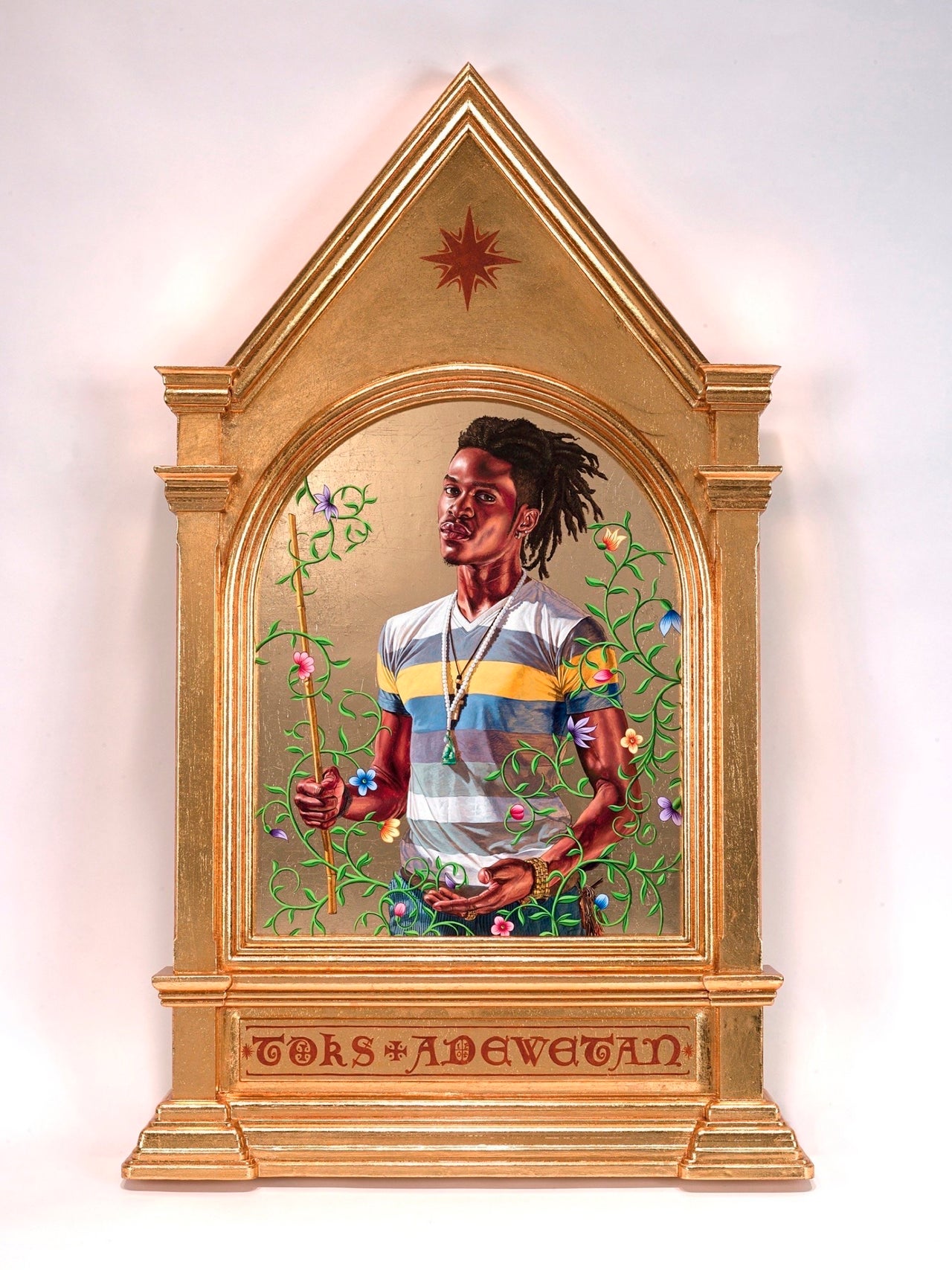
Courtesy: Sean Kelly New York
Some star painters might turn their noses up at the thought of their work appearing on the set of a soapy TV show, but Wiley consistently shows how arbitrary and confining the art world’s conventions can be. “I think Kehinde has been really smart about making sure his work has multiple audiences and [isn’t] just locked away in castles and museums where all people don’t have access to it,” Sargent said. “I think that is part of the genius of Kehinde Wiley.”
Kelly agreed, recognizing Wiley’s willingness to stir up categories both in his work and with his work. “He is part of a younger generation of artists who are very comfortable moving between high and low culture and across cultural boundaries,” he said. “Take ‘Napoleon Leading the Army over the Alps,’ which has a contemporary kid called Napoleon on a horse in a pair of Puma shoes and a hoodie. Kehinde is prepared to cross all those boundaries and deal with all of those high art transgressions.”
Obama’s official portrait, which won’t be revealed until early 2018, will likely not adhere to Wiley’s famed formula. Many of his critics and peers predict it will not feature a vibrant, textile backdrop nor a horse-riding Obama clad with sword or cane. But perhaps more important, Wiley need not adorn Obama with the traditional trappings of privilege and power to help white society grasp the authority he possesses. Obama has already transformed the way white America envisions mastery.
In fact, when Obama ran for president in 2008, his image was already iconic, thanks to a ubiquitous stencil portrait by street artist Shepard Fairey. The portrait featured the candidate’s stylized face in patriotic colors, with the word “hope” written underneath.
Fairey’s portrait may have defined Obama’s candidacy, but Wiley’s will define his presidency. The pairing is as bold as it is fitting: a young art star in conversation with the entire history of Western art, embracing its norms while broadening its scope. With profound self-awareness, Obama aligns himself with Wiley’s mission of entering a historically white sphere and mastering it as the world takes notice. Nearly a year after a new president was elected, Obama reminds his followers of how he sees himself and how history will remember him.
Wiley has described his artistic practice as a “way of saying yes to us” ― the black community, the queer community, all the individuals who aren’t typically memorialized in golden frames. The sentiment echoes Obama’s lyrical motto, “yes we can,” which followed him from his senate campaign in 2004 to his final speech as president in 2017. With his official presidential portrait, Obama manages to convey this message even without words, exuding the radical optimism that he hopes will define his legacy: Yes we can. Yes we did. Yes to us. Yes.
CORRECTION: A previous version of this story misstated Wiley’s age as 44.
Support HuffPost
The Stakes Have Never Been Higher
[ad_2]
Source link
Write a fun caption about these paw-painting master artists – South China Morning Post
[ad_1]
Write a fun caption about these paw-painting master artists South China Morning Post
[ad_2]
Source link
‘I’ve got a lot more paintings to do’: Loveland resident thanks Meals on Wheels driver, Loveland Police officer for saving her life in August – Loveland Reporter-Herald
[ad_1]
‘I’ve got a lot more paintings to do’: Loveland resident thanks Meals on Wheels driver, Loveland Police officer for saving her life in August Loveland Reporter-Herald
[ad_2]
Source link
Kehinde Wiley Was Destined To Paint Barack Obama
[ad_1]
The presidential portraits wing of the Smithsonian National Portrait Gallery is lined with paintings of very powerful and equally pasty men. Its walls, filled with bowties, powder wigs and pursed lips, speak two well-known truths at once: Both the history of American politics and the history of Western art are blindingly white.
In 2018, however, the gallery will receive an addition unlike the rest. As was reported earlier this fall, a portrait of former President Barack Obama will join the Smithsonian ranks next year, painted by 40-year-old contemporary art star Kehinde Wiley. As a result, Obama will become the first black president featured in the gallery, and Wiley (along with Amy Sherald, commissioned to paint Michelle Obama), the first black artist to grace its halls.
The former president and first lady hand-picked the artists who will render their official portraits. And those decisions hold weight. Antwaun Sargent, a 29-year-old critic who’s covered Wiley extensively, felt personally affected by Obama’s historic choice. “I grew up in Chicago,” he told HuffPost. “I knocked on doors in the dead of winter when Obama was running for Senate. To see him choose an openly queer, black man who has devoted his career to depicting black folks, it’s really full circle for me.”
Wiley’s paintings are easy to discern. Their backgrounds typically involve a florid design quietly creeping toward the fore, its composition a melting pot of British Arts and Crafts textiles and Dutch-made African wax prints. Up front is usually a figure ― young, attractive and black ― dressed in contemporary streetwear and mimicking the stances of Old Master heroes like Napoleon Bonaparte or Charles V.
Wiley’s painted subjects are often categorized as “normal,” in that they’re not particularly rich or famous, as portrait sitters for Titian or Jacques-Louis David tended to be. Wiley scouts his subjects himself, either on the streets of New York or through open casting calls. Like many artists, Wiley has an appreciation for beauty, but he gravitates toward a lesser documented masculine allure that manifests in hip style, performative swagger, defined muscles, tattoos and radiant black skin.
“Sometimes I’d walk through the galleries just to look at the way the faces and the hands are painted, all the nuances of black,” Eugenie Tsai, the Brooklyn Museum curator who organized a 2015 exhibition of Wiley’s work, recalled.
Courtesy of the Smithsonians National Portrait Gallery Photos by Matailong Du
Once immortalized in Wiley’s massive, gold-framed canvases (they can measure as large as nine feet tall), his subjects shift from regular people to mythic giants. They ride horses like Napoleon, wield swords like Willem van Heythuysen and pose flamboyantly like Andries Stilte II, all while wearing standard blue jeans and sneakers. Wiley imbues his sitters with a gravitas and glory historically reserved for patrons, nobles and saints. His works build upon the centuries-old relationship between portraiture and power, using the canonized language of art history to exalt a new kind of subject.
“He literally is the first person I know of, throughout the history of painting, who is appropriating the entire history of art ― from cave painting on ― and bending it to his will,” Sean Kelly, founder of Sean Kelly Gallery, the gallery that represents Wiley’s work, said. “The whole history of art becomes a narrative about black presence.”
Conversations about Wiley’s work often revolve around this one specific aspect: the idea of injecting brown bodies into an all-white canon. As the artist’s straightforward and affecting statement reads: “Painting is about the world that we live in. Black men live in the world. My choice is to include them. This is my way of saying yes to us.” However, Wiley’s paintings are not simply exercises in corrective representation ― making the invisible visible. They are intended to probe the mechanics of seeing and being seen.
“Many people see my early work simply as portraits of black and brown people,” Wiley told HuffPost in May. “Really, it’s an investigation of how we see those people and how they have been perceived over time. The performance of black American identity feels very different from actually living in a black body. There’s a dissonance between inside and outside.”
Sargent described a similar dissonance between a white mainstream perception of Wiley’s subjects and his subjects’ understandings of themselves. “Kehinde saw something in these people that the larger culture didn’t see,” he said. “He believed they were heroic, that they had power. He painted people the way they imagined themselves, the way society has always ignored.”
If conventional Western portraits calcify structural power, Wiley’s are vehicles for empowerment in and of themselves. They exist in the discordant space between assumption, reality and performance, where the self is as wrapped up in artifice as authenticity. There is, therefore, a parallel between how Wiley regards his subjects and how Obama, as a young man, imagined himself.
To fête an unlikely subject is “not unlike a black man saying ‘I’m going to run for president’ when everyone is saying ‘no you can’t,’” Sargent said.

Courtesy: Sean Kelly New York
For Tsai, another overlooked element of Wiley’s work is its queerness. Female beauty has remained a near constant source of inspiration for Western artists, but appreciation of male beauty, especially black male beauty by a black male artist, can still bring a jolt to the system.
“Instead of the male gaze ― men looking at women ― you have a sense that this is a man looking at men,” she said. “It’s no secret.”
Portraying his subjects with exuberance and a hint of kitsch, Wiley embraces queerness as a lens, challenging the shallow assumptions that often beset young black men. “Wiley doesn’t only challenge the white gaze, but also the cultural gaze and the role of masculinity,” Sargent said. “It’s about black men trying to negotiate gayness in the context of mainstream gay society which has its prejudices. ’If I don’t look this way, or if I don’t act this way, am I gay? Am I black? Can you still see me?’”
There is more to Wiley’s work than the goal of diversifying subjects and artists represented in the art world. Yet that initiative ― also undertaken by artists including Kerry James Marshall, the late Barkley Hendricks, Mickalene Thomas, as well as rising artists like Jordan Casteel, Henry Taylor, Njideka Akunyili-Crosby, Toyin Ojih Odutola and many more ― has tangible effects.
The Brooklyn Museum’s 2015 mid-career survey of Wiley’s work was wildly popular, drawing around 124,000 visitors over the course of three months. More than the numbers, curator Tsai was struck by the wide range of people entering the museum’s doors: art buffs and kids walking down Eastern Parkway, hip-hop aficionados and local families.
“For me, one of the most amazing things about the exhibition was eavesdropping on the conversations going on,” Tsai said. “It made me realize that everyone should have the experience of seeing someone who looks like you hanging on the walls of a cultural institution. You think of an exhibition as the work on the walls, but the interactions between the visitors and the works of art were crucial.”
Beyond expanding the scope of museum attendees, Wiley is also helping shape the next generation of collectors. “In the short term, he’s bringing a different audience to the work,” gallerist Kelly put it. “In the long term, he’s broadening the depth of collectors for the work. Kehinde’s work is capable of touching different audiences in different ways, so the collector base is much more diverse.”
Kelly speculated that these real-world effects drive Wiley as an artist. “I think after 4,000 years of being excluded from the narrative, he wants to make sure that the next generation of kids walking into a museum don’t have to experience what he did. I think he wants everybody to feel like what they’re looking at represents them and in some way speaks to them.”

Courtesy: Sean Kelly New York
Wiley grew up in South Central, Los Angeles, with five siblings ― including a twin brother ― and his mother, who worked as a linguist before opening a junk shop in the neighborhood. Wiley was influenced by his mother’s linguistic work, which explored the friction between American Standard English and the black vernacular and code-switching black kids adopt as a method of survival.
As an adult, cast in the role of “contemporary black artist,” Wiley is cognizant of the multiple worlds he inhabits and the distinct languages each requires. “It’s about being able to play inside and outside of the race narrative at once,” the San Francisco Art Institute and Yale University School of Art alumnus said. “It’s difficult to get right.”
In a 2017 series, Wiley painted prominent black artists as “Tricksters,” fabled master code-switchers, to illustrate their dexterity in mythic terms. Rashid Johnson, an artist featured in the series and a friend of Wiley’s since 2001, described the experience of sitting for Wiley as very organized and comfortable. “I don’t think he changes personalities but he takes on a more directorial position,” he told HuffPost. “It’s Kehinde but a little more serious.”
Outside the studio, Wiley’s peers describe him as brilliant, energetic and incredibly present. “He’s one of those people who walks into the room and the temperature changes,” Kelly said.
Wiley currently has two running studios ― one in Brooklyn, one in Beijing ― and is building a third in Senegal. The spaces operate like the traditional Renaissance studios of Leonardo or Michelangelo catapulted into a postmodern, 21st-century laboratory, with assistants ushering his large-scale ideas into being. The conceptual work is Wiley’s alone, but the task of painting is divvied up among a number of assistants who’ve mastered his stroke.
This studio setup, despite its significant art historical precedent, interrupts the persistent fantasy of the monogamous relationship between artist and artwork. As Wiley explained to GQ’s Wyatt Mason: “The sentiments about authenticity in the public eye, the discomfort with a large-scale art practice, comes from a myth in an artistic process that never existed.”
Wiley romanticizes neither the creation of art nor its valuation. “Wiley acknowledges that he makes high-end products to sell,” Tsai said. “It’s partially tongue in cheek, but it’s part of his practice.” The understanding that art is not something precious and invaluable, but in fact, something very valuable, frees Wiley up to exhibit his work outside the typical art world-approved venues. In 2009, Wiley partnered with Puma on a collection of clothing, shoes and accessories incorporating the graphic patterns from his paintings’ backdrops. His work also appears on the set of Fox drama “Empire,” in the gilded apartment of Terrence Howard’s character Lucious Lyon.
“We wanted the character to be like a Jay-Z,” set decorator Caroline Perzan said. “So the question was: what would Jay-Z have at his penthouse in New York?” Wiley’s portraits ― flashy, epic, instantly recognizable and widely coveted ― were a perfect choice. Because the selected paintings, including “Officer of the Hussars,” were either hanging in museums or otherwise occupied, Perzan bought the rights to the images, then printed them onto high-quality canvases and framed them.

Courtesy: Sean Kelly New York
Some star painters might turn their noses up at the thought of their work appearing on the set of a soapy TV show, but Wiley consistently shows how arbitrary and confining the art world’s conventions can be. “I think Kehinde has been really smart about making sure his work has multiple audiences and [isn’t] just locked away in castles and museums where all people don’t have access to it,” Sargent said. “I think that is part of the genius of Kehinde Wiley.”
Kelly agreed, recognizing Wiley’s willingness to stir up categories both in his work and with his work. “He is part of a younger generation of artists who are very comfortable moving between high and low culture and across cultural boundaries,” he said. “Take ‘Napoleon Leading the Army over the Alps,’ which has a contemporary kid called Napoleon on a horse in a pair of Puma shoes and a hoodie. Kehinde is prepared to cross all those boundaries and deal with all of those high art transgressions.”
Obama’s official portrait, which won’t be revealed until early 2018, will likely not adhere to Wiley’s famed formula. Many of his critics and peers predict it will not feature a vibrant, textile backdrop nor a horse-riding Obama clad with sword or cane. But perhaps more important, Wiley need not adorn Obama with the traditional trappings of privilege and power to help white society grasp the authority he possesses. Obama has already transformed the way white America envisions mastery.
In fact, when Obama ran for president in 2008, his image was already iconic, thanks to a ubiquitous stencil portrait by street artist Shepard Fairey. The portrait featured the candidate’s stylized face in patriotic colors, with the word “hope” written underneath.
Fairey’s portrait may have defined Obama’s candidacy, but Wiley’s will define his presidency. The pairing is as bold as it is fitting: a young art star in conversation with the entire history of Western art, embracing its norms while broadening its scope. With profound self-awareness, Obama aligns himself with Wiley’s mission of entering a historically white sphere and mastering it as the world takes notice. Nearly a year after a new president was elected, Obama reminds his followers of how he sees himself and how history will remember him.
Wiley has described his artistic practice as a “way of saying yes to us” ― the black community, the queer community, all the individuals who aren’t typically memorialized in golden frames. The sentiment echoes Obama’s lyrical motto, “yes we can,” which followed him from his senate campaign in 2004 to his final speech as president in 2017. With his official presidential portrait, Obama manages to convey this message even without words, exuding the radical optimism that he hopes will define his legacy: Yes we can. Yes we did. Yes to us. Yes.
CORRECTION: A previous version of this story misstated Wiley’s age as 44.
Support HuffPost
The Stakes Have Never Been Higher
[ad_2]
Source link

